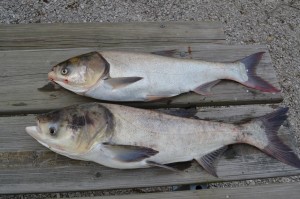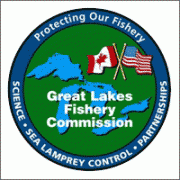Risk Assessment Highlights Need for Urgent Action to Prevent Establishment of Asian Carps
The Great Lakes Fishery Commission today received a much-anticipated report assessing the risk of Bighead and Silver Carps to the Great Lakes. The risk assessment concluded that these two species of Asian carps pose a substantial risk to the Great Lakes if they become established. While the arrival of Asian carps into the Great Lakes is looming, the establishment and the resulting ecosystem damage is not a foregone conclusion if governments take additional action. The report noted that although several pathways for bighead and silver carps exist, the Chicago Area Waterway System poses the greatest risk. The sixteen-month risk assessment project was led by Fisheries and Oceans Canada and included a team of scientists from both Canada and the United States. The results were peer-reviewed by a team of experts. The Great Lakes Fishery Commission facilitated the binational effort. A copy of the risk assessment is available online at http://www.dfo-mpo.gc.ca/csas-sccs/Publications/ResDocs-DocRech/2011/2011_114-eng.html.

Silver (top) and Bighead (bottom) Carps. Photo credit: Asian Carp Regional Coordinating Committee (http://asiancarp.us/).
Bighead and Silver Carps originating from Asia (commonly referred to as “bigheaded carps”, two of four species of “Asian carps”) were imported into the United States in the 1970s to keep aquaculture facilities clean and to manage waste. They were also imported as a foodfish for aquaculture, with the hope of creating a domestic market. The bigheaded carps escaped into public waterways (e.g., the Mississippi River) through flooding events in the 1970s, 1980s, and 1990s. Because these fish spawn and thrive in high water, several years of consistent flooding created prime conditions for extremely strong year classes, which further allowed for rapid growth in populations. The Chicago Area Waterway System (CAWS), a series of canals and rivers in and near Chicago, is a manmade connection of the Great Lakes and Mississippi River basins. The waterway is a vibrant transportation corridor, a route for pleasure boats, and a water management system. The CAWS is also the most-likely pathway for bigheaded carps, the risk assessment concluded.
“The report released today represents a state-of-the-art understanding of the risks posed by Bighead and Silver Carps to the Great Lakes” said Robert Lambe, vice-chair of the Great Lakes Fishery Commission. “Fisheries and Oceans Canada conducted this assessment using the highest standards of science, and took substantial steps to have the assessment peer-reviewed by experts in the field. Moreover, by involving both Canadian and American scientists in the assessment, the report drew upon the wealth of expertise in both countries to help us best understand the risk Asian carps pose to the Great Lakes. The commission expects that the assessment will inform decisions around the management and prevention of Asian carps.”
Michael Hansen, the commission’s chair added: “This Asian carp risk assessment is sobering. It concludes that arrival of Asian carps is looming, and should the fish become established in the Great Lakes, that their effects on the ecosystem would be severe. No lake is spared, with embayments and Lake Erie particularly vulnerable. The Great Lakes contain ample food for Asian carps and ample spawning habitat, making their spread highly likely, even into comparatively less-hospitable places like Lake Superior.”
Hansen added: “We must support every effort to keep bighead and silver carps and other invasive species out of the Great Lakes. Invasive species threaten the $7 billion fishery and they hurt the economy by undermining tourism, jobs, and prosperity. This risk assessment, while stressing the substantial risk Asian carps pose to the Great Lakes, is also reason for all relevant agencies to redouble their efforts to prevent an invasion. The carps are not yet established in the Great Lakes which means we still have time avoid the severe consequences of Asian carps presented in this risk assessment.”
The Great Lakes Fishery Commission (and many others) has repeatedly identified re-establishing the natural separation between the Great Lakes and the Mississippi River. Also, in March, 2010, citizen advisors to the commission—from both Canada and the United States—passed a joint resolution making the same recommendation (http://www.glfc.org/staff/resol2010_1.pdf). Most recently, the Great Lakes Commission and the Great Lakes and St. Lawrence Cities Initiative released the results of their major study investigating ways to achieve separation between the two basins. Information about that study is online at http://projects.glc.org/caws/. Also, the U.S. Army Corps of Engineers is conducting a study (GLMRIS) to investigate ways to prevent the movement of species between the Great Lakes and Mississippi Basins. More information about the corps’ study can be found at http://glmris.anl.gov/. The binational risk assessment released today further emphasizes the need for separation to occur.


